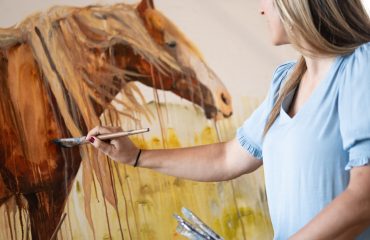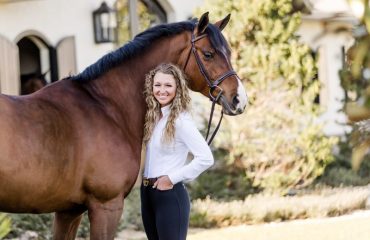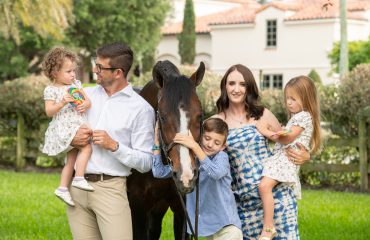
Triumphant in 1998 at Rolex Kentucky Three-Day Event: Dorothy Trapp and Molokai enjoy their victory gallop after finishing second overall in the inaugural CCI*** and winning the first-ever National four-star championship. (Photo Courtesy of Visionaire)
By Lauren R. Giannini
In the final decade of the 20th century, Dorothy Trapp Crowell rode into the record books with Molokai, her off-the-track Thoroughbred horse of a lifetime. Their extraordinary partnership harvested great international success in the “long format” era of three-day eventing. The four-part endurance test covered about 20 miles and consisted of roads & tracks (A & C), steeplechase (B) and cross-country (D). The long format catered to Mo’s strengths. He acted as if he could gallop forever. He was a fearless, bold, scopey jumper and nothing fazed him.
“Molokai was the Michael Jordan of event horses,” said Dorothy. “Michael was a great basketball player who could run the court, jump and score baskets. Mo was an amazing athlete and, like Michael, could do everything he attempted.”
In 1994, a measly two-tenths of a point penalty, picked up on steeplechase, kept them from winning the World Championship at The Hague, Germany. “Molokai had the best gallop and was always able to make the time, but halfway around the steeplechase, he lost all rhythm. I knew I had to pull him up,” said Dorothy. “He was strong and it wasn’t easy. By the time I got him to trot, he was smoothing out. I’m hanging off the side trying to see if a shoe is off, but he walked normally and I picked up a quiet canter — no indication of anything wrong. We jumped the next fence and then, for the first time in Mo’s life, I asked him to go as fast as he could go.
“I did the right thing pulling him up but then it was scary how fast he was moving, but also the premier ride of my life,” continued Dorothy. “Mo almost made the time. He was amazing — like driving a really good sports car and you’re shocked when you see you’re doing 100 miles per hour. Mo was going so fast, tears streamed out of my eyes. I’m glad I pulled him up to make sure he wasn’t injured.”
Their second place finish and silver medal provided both consolation and cause for celebration that they were that close to winning. “Molokai did spring a shoe, but I don’t regret missing out on the championship,” said Dorothy. “I knew then with complete and total confidence, just as I know now, that Molokai was the best horse in the world.”

Molokai (1983–2013) partnered with Dorothy in the 1990s, shown here wearing his 1994 WEG silver medal sheet. A failed racehorse (career earnings of $720), Mo galloped and jumped into equestrian history books with Dorothy. (Photo by John Crowell)
Equestrian History
Thus began the trend of impressive horse-and-rider combinations bringing home individual medals for the U.S. in international three-day competition. Dorothy and Molokai were first, followed by the late Amy Tryon and Poggio II, Kim Severson and Winsome Adante and Gina Miles and McKinlaigh. Dorothy and Mo also tackled the UK’s celebrated four-stars: Burghley — eighth in 1992, fifth in 1993, and a top 15 finish at Badminton in 1997.
In 1998, Dorothy and Molokai wrote themselves into equestrian history by winning the first-ever National four-star championship as the highest-placed American duo, finishing second in the inaugural CCI**** at Rolex Kentucky. Molokai was the only horse to go double clear on the cross-country. As the hometown favorite and being Kentucky-bred, Mo was cheered every meter of Phase D’s 14-minute cross-country course.
That Rolex four-star was also Molokai’s swan song. He lived out his retirement with Dorothy, even traveling to Florida with her in the winter, until December 2013 when the horse gods took back one of their own. Dorothy planted a garden on Mo’s final resting place at Sycamore Hill Farm.
Dorothy and Molokai are proof that the dreams of horse-crazy kids can come true. The bottom line is desire to learn, determination to succeed, willingness to work and the will and the heart to try even harder. They kept challenging their comfort zones, performing with the sort of razzle-dazzle brilliance that’s difficult to ignore. It all goes back to when the very foundation of Dorothy’s horsemanship experienced a total makeover when she was a working student.

The new signpost at Sycamore Hill Farm says it all. Dorothy Crowell loves to teach and knows exactly what it takes to travel those distances to Rolex, Burghley, Badminton, etc. (Photo by John Crowell)
Working Student Isn’t a Free Ride
Dorothy’s horse history began like many young riders. She begged for a pony for years and finally her parents relented. Peaches & Cream was only 13 hands, but at 14 Dorothy was already 5’9”. “All I ever did was pet her, because she was tiny and I was too big,” said Dorothy. “Eventually I got an Appaloosa named Summerhill, who taught me more about defensive riding than any other horse. He taught me to be completely ambidextrous with my crop, how to stay behind the motion and how to ride the saddle to the fence! I still use those lessons. My third horse was a wonderful off-the-track Thoroughbred, Waldo Pepper. Wally probably began my love affair of Thoroughbreds. He wasn’t the soundest horse, but he was the classic Thoroughbred with heart, work ethic and patience.”
Wally took Dorothy through Training Level by the time she was getting ready to go to college. She recalled staring at her poster of Bruce Davidson and Irish Cap and asking, “How did you get there?” because she couldn’t figure out how to get where she wanted to go. Soon after, she read an article by Denny Emerson about working students.
“I thought there was a way you could ride and go to school — it was my perfect solution so that my parents would be happy,” said Dorothy. “I called and spoke to May Emerson and she explained that the world of working students was not what I thought it was. So that idea crashed and burned. Then, my parents were talking with some of their friends about the fact that I was inspired only by one thing, no matter what they tried, and that was horses, but they weren’t very excited about it.
“The friends told my parents to send me to Torrance Watkins,” continued Dorothy. “They said, if I survived being a working student with Torrance that my parents had to give up and get behind me because, a) Torrance would give me a really good foundation — which she did, and b) that she would not pull any punches; she’d be very strict in her insistence about work ethic and hard work, that I’d learn at Torrance’s just how tough life with horses was going to be. Unfortunately for my parents, I came away from my working student experience wanting to do it and, if anything, I knew that I wanted that life with horses even more than before I went to Torrance.”

Dorothy and Molokai: “The truth is that we were never featured on the Wheaties box,” stated Dorothy. “Diana Rich, my really good friend and an event rider from Ohio, put it all together, using a real box with the Olympic symbol on it. She cut out and pasted our photo on there, made it look real, then shrink-wrapped it for me.” (Photo courtesy of EventingNation.com and Samantha L. Clark)
Building a Foundation
Torrance Watkins, 1984 Olympic team gold medalist, doesn’t beat around the bush. “I went to Virginia as a working student for Torrance,” recalled Dorothy. “She had Finvarra and made the team for Los Angeles while I was there and I left just before the Olympics. I was there one and a half years. Torrance gave me that drive and completely redid the foundation of my horsemanship — so much of what I do with horse stuff, in training and in teaching, it all goes straight back to Torrance.
“I’ve had my own experiences with working students — some barely lasted a week,” continued Dorothy. “It was similar at Torrance’s. I think the problem is that so many kids, like me, have absolutely no idea what being a working student means. I try to find out what they know and suggest that they come for the weekend. I provide the names and numbers of present and former working students who have been given a heads up to tell everything — the good, the bad and the ugly. What I look for is a working student who wants to learn, not someone who expects to be told how great they are. When you sign on as a working student, you need to be ready to undergo a complete transformation.”
That’s exactly what happened. Dorothy thought she was okay, not great, doing Training Level, but when she rode for Torrance, the list of things to work on was humongous. She felt demoralized and considered going home. “Then Torrance said, ‘Let’s start working at the beginning’ and she completely rebuilt the way I ride,” said Dorothy. “Not everybody who comes to me wants that kind of help, but working students are putting themselves out there for that kind of transformation. The ones who stick it out, the changes in their riding and horsemanship are exciting and I find it incredibly gratifying.”
It’s important to understand that not all working students are going to Rolex. “Some are Beginner Novice or Novice or Training Level riders who want to be confident and great at their level,” said Dorothy. “It’s fun watching them make that transformation. It’s fun when it applies to people who want to do it at the upper levels. I’ve had more students do the two-star level than the three- or four-star levels. It’s very difficult, and financially very expensive. You have to find the right horse. You have to have the backing. You have to have the work ethic yourself. The timing has to be right and the horse has to stay sound. It isn’t easy, but if someone wants to do this, I know what it takes and I love to teach.”

Tassimo, an off-the-track Thoroughbred, tackles Novice Horse with Dorothy at Rocking Horse Winter 1 Horse Trials (Florida). Tassimo jumped clear cross-country, finishing sixth. (Photo by John Crowell)
The Next Phase
Today, Dorothy has a full and active life, personally and professionally. She teaches, trains, coaches and shows her young prospects. Yet, her priorities have shifted to allow time with her husband, John, and their teenage daughter, Juliette. Gone are days of over-the-top commitment to achieve upper levels and compete internationally. Dorothy has found balance in her equestrian life and she’s reaping the rewards.
“At Sycamore Hill Farm, I have a small barn with nine stalls and four of them are for my horses and for my husband’s — he recently gotten back into riding — but we don’t keep a lot of horses on the farm,” said Dorothy. “It’s really better that way. My students trailer in. It’s a quieter way of life.”
There’s room for a working student or two. That’s where Dorothy’s background comes in really handy. She worked hard for her success. She’s bluegrass, born and bred. Her grandfather, Leslie Combs II, founded Spendthrift Farm, named for the great-grandsire of Man O’ War. Her parents missed out completely on horsy genes and didn’t share their daughter’s enthusiasm. It didn’t matter. She lived her dream and loves to share her knowledge.
Dorothy is a Level IV instructor in the U.S. Eventing Association’s Instructor Certification Program, part of Area VIII’s coaching team with Cathy Wieschhoff, Sharon White and Robin Walker. She teaches at the Area VIII riders’ camp, one in Michigan, one in Kentucky and also teaches clinics.
A recent post on Dorothy’s Facebook page pretty much sums up who she is: “It’s not about the money with her, it’s about a pure sport, the welfare of the horse and rider but she challenges you and your horse. She makes time for people.”
For more information, visit facebook.com/sycamorehillfarm.













